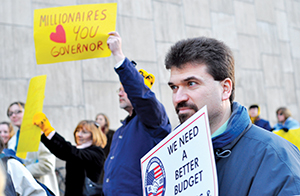
New York state Gov. David Paterson ordered a $500 million cut in current-year spending for state agencies — $90 million of which will be cut directly from the State University of New York system.
The cut reflects an approximate 11 percent decrease across the board from each state agency’s non-personal services budget, according to a press release from the office of the governor. The $500 million cut for the 2009-10 year, when combined with the 10 percent across-the-board reductions of the 2008-09 year, would save the state an annual recurring amount of $1.5 billion.
The 2008-09 budget cut reduced funding for the SUNY system by $146 million after three rounds of cuts. In addition, last year, SUNY trustees adopted a statewide tuition increase of $310 per semester for in-state undergrads and $1,130 for out-of-state undergrads, effective spring 2009 and into the current academic year.
Paterson and the New York state legislature took 90 percent, or $62 million, of the spring 2009 SUNY and City University of New York tuition hike.
SUNY, which consists of 64 university and college campuses across the state, is seeing the largest loss of money of all of the state agencies, right above correctional services, which will be cut $69,291.
In addition, Paterson proposed taking 80 percent, or $122 million, of the 2009-10 academic year’s tuition. This was in addition to 2008 cuts in state support that the SUNY system already endured, totaling $210 million, which included $6.5 million of BU’s funds.
According to a letter to agency commissioners from the New York State Budget Director Robert L. Megna, the most recent cuts in agency expenditures are necessary because of a current-year deficit of at least $2.1 billion.
How SUNY will allocate the $90 million in cuts across the campuses is at the discretion of SUNY leadership, said Matt Anderson, spokesman for the Division of the Budget of New York.
“SUNY recognizes that the fiscal crisis continues to affect the state,” said David Henahan, director of media relations for SUNY. “Chancellor Zimpher will meet with a group of campus presidents and business officers to discuss how to best manage the latest budget reduction. SUNY will do all it can to protect the quality of the education our students receive, but this is increasingly difficult at a time of scarce resources.”
According to Henahan, while SUNY figures out how to divide the cuts, campuses will continue to implement soft and hard hiring freezes, redirect resources and delay and eliminate programs and purchases. This could lead to larger class sections, fewer course offerings and reductions in other services.
“At this point, we do not have specific information from SUNY administration regarding how these reductions will be allocated among the campuses,” said James Van Voorst, vice president for administration at Binghamton University. “We will be working very closely with SUNY in the coming weeks to determine exactly how these cuts will impact the Binghamton University campus. We recognize that this is a challenging time for New York state and for Binghamton University.”
At the first Student Assembly meeting of the semester, BU President Lois DeFleur predicted that BU could face another wave of substantial cuts.
According to DeFleur’s speech at the meeting, BU’s stance is that a decline in state funding is the wrong direction for the state government, as students of the SUNY system are the educated future of the state.
The SUNY Student Assembly agrees with DeFleur’s message and is in the beginning stages of creating a concrete plan to make sure state legislatures know the faces of those whom the budget cuts are effecting.
“This $90 million cut in current spending is only the first step,” said Juliette Price, director of communications for SUNY Student Assembly, and a senior at SUNY Oneonta. “The $90 million in cuts is an executive order and do not have to pass state legislation; legislatures did not have to vote on it.”
According to Price, the SUNY Assembly will meet at BU from Oct. 23 to 25 for their annual conference.
“Paterson is going back to the legislatures,” she said. “Our main focus is going to be talking to legislatures and letting them know that it is not O.K. to cut SUNY. Elections are coming up and they need to keep that in mind. We are going to pressure them … cutting SUNY is not the solution.”
Paterson’s office is currently working with the legislatures since the current cut only represents one-sixth of the actions needed to be taken to clear the deficit, Anderson said.
“Unfortunately, the reality we are faced with is a time of record revenue decline,” he said. “Any additional reductions will be allocated by the legislatures.”


